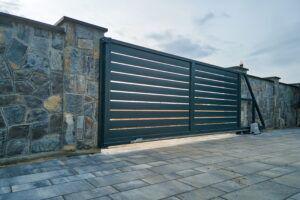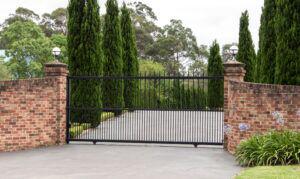Choosing the right gate for your property is a significant decision that impacts security, accessibility, and curb appeal. A well-chosen gate complements your fencing, provides reliable access, and enhances the overall value of your home or business. Two of the most common and effective options for driveway access are cantilever and rolling gates. While both serve a similar purpose, they operate differently and offer distinct advantages.
Understanding these differences is key to making a confident investment. This guide will provide a detailed comparison of cantilever and rolling gates, covering their design, operation, and ideal applications. We will explore the pros and cons of each, helping you determine which solution best fits your property’s unique requirements.
What Is a Cantilever Gate?

A cantilever gate is a sliding gate that does not have wheels on the ground. Instead, it operates on a series of rollers attached to posts set back from the opening. The gate itself is built longer than the opening it secures, with a counterbalanced section that runs parallel to the fence line. This design allows the gate to slide open and closed smoothly without any ground contact.
Design and Materials
Cantilever gates are engineered for strength and stability. They require a robust frame to support the gate’s weight across the opening without sagging. Common materials include:
- Steel: Prized for its exceptional strength and durability, steel is a popular choice for large, heavy-duty cantilever gates, especially in commercial or industrial settings.
- Aluminum: Lightweight, corrosion-resistant, and versatile, aluminum is an excellent option for residential cantilever gates. It can be easily customized and requires minimal maintenance.
The gate’s structure includes the main gate panel and a “tail” or counter-balance section, which is typically about one-third to one-half the length of the opening. This tail is essential for the gate’s function, as it holds the rollers that support the entire structure.
What Is a Rolling Gate?

A rolling gate, also known as a slide or track gate, operates by rolling along a track installed on the ground across the driveway opening. It features wheels or casters at the bottom of the gate frame that guide it along this track. Additional roller guides at the top of the gate, attached to posts, keep it upright and stable as it moves.
Design and Materials
Rolling gates are a practical and widely used solution for properties of all types. Because the track provides continuous support, the gate’s frame does not need to be as heavily reinforced as a cantilever gate.
- Wrought Iron: Often chosen for its classic, ornamental appearance, wrought iron adds a touch of elegance to residential properties.
- Chain Link: A cost-effective and functional choice, chain-link rolling gates are common in both commercial and residential applications where security is the primary focus.
- Wood: For a natural and private aesthetic, wood panels can be attached to a metal frame to create a beautiful and secure rolling gate.
The defining feature is the ground track, which must be installed on a level, solid surface like concrete to ensure smooth operation.
Comparing Cantilever and Rolling Gates
To help you decide which gate is the right fit for your property, let’s compare them across several key factors.
Installation
- Cantilever Gate: The installation process is more complex. It requires precise measurements and the pouring of significant concrete footings for the support posts and roller assemblies. Since there is no ground track, the driveway surface itself requires less preparation. However, the gate needs considerable space alongside the fence for the counter-balance tail to retract into when opened.
- Rolling Gate: Installation is generally more straightforward and less expensive. The primary task is installing the track on the ground, which must be perfectly level. This may require pouring a concrete strip if a suitable surface doesn’t already exist. The gate posts do not bear the same load as a cantilever system, simplifying their installation.
Advantage: Rolling Gate (for simplicity and lower initial cost).
Maintenance and Durability
- Cantilever Gate: These gates are known for their low maintenance and high reliability. Since there are no ground components, they are not affected by debris, snow, ice, or uneven ground. The enclosed roller mechanisms are protected from the elements, reducing wear and tear. This makes them exceptionally durable, especially in regions with harsh weather.
- Rolling Gate: The ground track is the primary point of failure. It can become clogged with leaves, dirt, gravel, or snow, obstructing the wheels and preventing the gate from opening or closing smoothly. The wheels themselves are also exposed to wear and can require periodic replacement. Regular cleaning of the track is essential for reliable operation.
Advantage: Cantilever Gate (for reliability and lower maintenance needs).
Suitability for Different Properties
- Cantilever Gate: These gates are the ideal solution for properties with uneven ground, gravel driveways, or steep slopes where a ground track would be impractical. They are also superior in areas with significant snowfall, as a plow can clear the driveway without damaging a track. Their need for extra space for the tail can be a limitation on properties with limited side room.
- Rolling Gate: A rolling gate is an excellent choice for properties with flat, level driveways and limited space next to the fence line. Since it doesn’t require a counter-balance section, the gate only needs a space equal to the width of the opening to retract into. This makes it suitable for tighter spaces.
Advantage: It depends on your property. A cantilever gate offers more versatility for challenging terrain, while a rolling gate is more space-efficient.
Cost
- Cantilever Gate: The initial investment for a cantilever gate is typically higher. The cost reflects the more complex engineering, heavier-duty materials required for the frame, and the extensive groundwork needed for the footings.
- Rolling Gate: Rolling gates are generally more budget-friendly. The materials and hardware are less expensive, and the installation process is simpler, resulting in lower labor costs. However, potential long-term maintenance costs for track and wheel repairs should be considered.
Advantage: Rolling Gate (for lower upfront cost).
Making the Right Choice for Your Needs
Selecting the right gate comes down to balancing your budget, property layout, and long-term expectations.
- Choose a cantilever gate if:
- Your driveway is on a slope or has an uneven surface. If your entire property is sloped, check out our how to install a fence on a slope guide for more sloped property tips)
- You live in an area with heavy snow or frequent debris.
- You prioritize low maintenance and long-term reliability.
- You have ample space alongside your fence for the gate to open fully.
- Choose a rolling gate if:
- You have a flat, level driveway made of concrete or asphalt.
- Your budget for the initial installation is a primary concern.
- Space is limited next to your fence line.
- You are prepared to perform regular maintenance by keeping the track clear.
Secure Your Property with Expert Guidance
Both cantilever and rolling gates are effective solutions that enhance property security and convenience. By understanding their core differences, you can select an option that delivers lasting performance and value. Each component we install consists of top-quality materials and is thoroughly tested to withstand daily use and the elements.
If you are ready to find the perfect gate for your fence, our team is here to help. Contact Top Rail Fence today for a free, no-obligation consultation. We will assess your property, discuss your needs, and design a personalized gate installation solution that provides the security and style you deserve.


